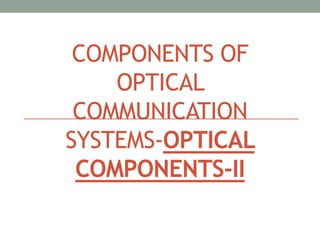
7. lecture=11 12 splitters, isolators
- 2. Passive Optical Components Passive optical components play a vital role in an optical network Some of the major tasks performed by passive components are: 1. Coupling or splitting of signals, 2. Wavelength multiplexing/demultiplexing and 3. Isolation of backward reflections In the following discussion, we introduce the most commonly used passive optical components in communication systems
- 3. Optical Couplers/Splitters and Multiplexers/ Demultiplexers Couplers are used for either combining or splitting optical signals The most common type of couplers is the fused fiber coupler It is fabricated by simply fusing two optical fibers together When two fibers are brought close to each other and aligned appropriately in parallel, light is coupled from one to the other The amount of coupling depends on how close the parallel fibers are to each other
- 4. Optical Couplers/Splitters and Multiplexers/ Demultiplexers
- 5. Optical Couplers/Splitters and Multiplexers/ Demultiplexers A pair of the free ends is used as the input port, while the other free pair is used as the output port, as shown in Figure The amount of light output from the two output ports may be controlled by adjusting the distance between the two fused fibers, as well as by varying the parallel coupling lengths of the fibers
- 6. Optical Couplers/Splitters and Multiplexers/ Demultiplexers The principle of a multiplexer is quite similar to that of a coupler A multiplexer has multiple inputs and a single output A demultiplexer uses a combination of optical splitters and filters The splitter is used for dividing the input signal into multiple paths, while the filters separate particular frequencies The AWG filter discussed earlier can be used to multiplex or demultiplex optical signals
- 7. Optical Isolator The operating principle of optical isolators and circulators is similar An isolator allows light to pass through it in one direction, while attenuates the light passing in the opposite direction Isolators are mainly used at the output of optical amplifiers and lasers so as to protect them from any light reflecting backwards In an optical network, light travelling in a particular direction can get reflected at the interface of different components in the link - due to a change of refractive index
- 8. Optical Isolator The light signal which is composed of two orthogonal polarization states is passed through a spatial walk-off polarizer (SWP) SWP has different refractive indices for different polarizations This variation in the refractive index results in spatial separation of the two orthogonally polarized lights, while travelling through the SWP The polarization states of the light signal are shown by the circles in Figure next slide
- 10. Optical Isolator At the output of the SWP, two light signals having orthogonal polarization states are generated These two signals are passed through a Faraday rotator, which rotates the polarization state of each by 45◦ The Faraday rotator is a non-reciprocal device, hence it always rotates the polarization state by 45◦ regardless which side the light enters into the rotator from After the Faraday rotator, the light is passed through a half- wave plate
- 11. Optical Isolator Half-wave plate is a reciprocal device, hence light entering from the left is rotated by 45◦ in the clockwise direction, while light entering from the right is rotated by 45◦ in the anti-clockwise direction As observed from Figure, the combination of the Faraday rotator and the half-wave plate changes the polarization axis by 90◦ At the output, another SWP is used that operates in an inverse fashion w.r.t the SWP used at the input
- 12. Optical Isolator Therefore, the two light signals with different polarization axes are combined to form a single signal By contrast, for light entering in the opposite direction, that is from right to left, the combination of the half-wave plate and the Faraday rotator cancel the effect of each other Therefore, the states of polarization remain unchanged, which results in scattering the two light signals at the output of the final SWP, as shown in Figure (b) next slide
- 13. Optical Isolator
- 14. Optical Isolator The operating principle of a circulator is similar to that of the isolator The only difference is in the number of ports, with the isolator being a two-port device, while the circulator can have 3 or 4 ports, depending upon its specific application In a three-port circulator light entering from port 1, 2 and 3 exits through port 2, 3 and 1, respectively, as shown in the figure next slide
- 15. Optical Isolator
- 16. FBG Filter Using Optical Isolator
- 17. Optical Components - Summary Optical transmitters are composed of CW or pulsed laser sources which may be directly or externally modulated with the electronic data signal The optical signal is transmitted over the optical fiber which is generally manufactured from silica Like any other transmission channel, the optical fiber induces impairments over the signal due to its attenuation, dispersion and nonlinearity
- 18. Optical Components - Summary The optical receiver is generally a photo-diode, which generates electronic carriers upon detecting light These carriers constitute the output current of the optical receiver which is proportional to the amount of light received In order to compensate for the attenuation of the optical fiber, optical amplifiers are used in the network at regular intervals The most commonly used optical amplifier is the EDFA
- 19. Optical Components - Summary The operating principle of the optical filters is generally based on the interference of light The commonly used optical filters are Grating filters, Arrayed Waveguide filters, fiber Bragg filters and Fabry-Perot filters Optical couplers and multiplexers or splitters and demultiplexers are required in order to combine or separate multiple optical signals, respectively The flow of the optical signal is controlled using optical isolators and circulators